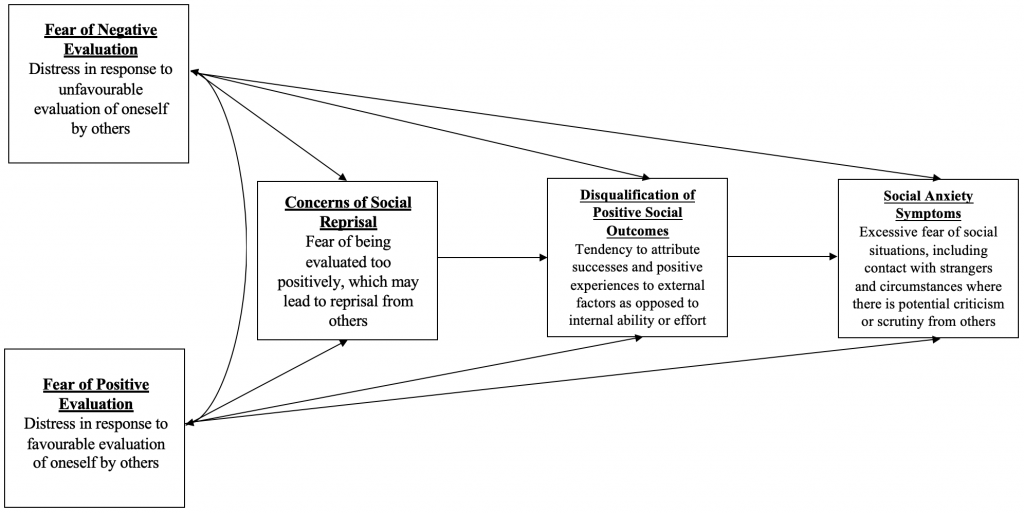Social anxiety disorder
Social anxiety disorder (also known as social phobia) is an anxiety condition characterised by excessive fear (and avoidance) of social situations, including contact with strangers and circumstances where there is potential criticism or scrutiny from others. Bladder and bowel anxiety conditions are most likely to besubtypes of social anxiety disorder.
Prevalence of social anxiety disorder
Social anxiety disorder is a common mental health problem that affects 1 in 7 Australians (14.40%) with symptoms typically starting in adolescence.
Theories ofsocial anxiety disorder
To date, several theories (also referred to as models) have been developed to explain the psychosocial processes involved in social anxiety disorder. A common theme present in models of social anxiety includes fear of negative evaluation (distress in response to unfavourable evaluations of oneself by others) along with cognitive and behavioural features.
The bivalent fear of evaluation model of social anxiety was recently developed by Weeks and Howell’s (2012). This model suggests that the fear of negative evaluation (distress in response to unfavourable evaluations of oneself by others e.g., “did you make that smell”) and fear of positive evaluation (distress in response to favourable evaluations of oneself by others e.g., feeling uneasy when attaining praise from authority figures) leads to social anxiety symptoms.
In 2018, Cook, Meyer, and Knowles extended the bivalent fear of evaluation model. Their research provided support for an extended bivalent fear of evaluation model of social anxiety. Several psychosocial factors were identified to predict social anxiety symptoms (see below for pictorial presentation):
- Fear of negative evaluation (distress in response to unfavourable evaluation of oneself by others e.g., “you should have got to the restroom before you made that mess”)
- Fear of positive evaluation (distress in response to favourable evaluation of oneself by others e.g., “I feel uneasy when I get praise from authority figures”)
- Concerns of social reprisal (fear of being evaluated too positively, which may lead to reprisal from others, e.g., “I get concerned others will ‘put me in my place’”)
- Disqualification of positive social outcomes (attributing successes and positive experiences to external factors as opposed to internal ability or effort e.g., thinking that one will only get along with people who are easy to talk to)

Study abstract: Social anxiety disorder is a mental health condition that affects 4.7% of Australians each year. The complex interplay between psychoevolutionary and cognitive models has become the focus of research in recent years, particularly with the development of the bivalent fear of evaluation model (i.e., negative and positive evaluation fears). The present study aimed to test a model of social anxiety symptoms using structural equation modelling, integrating previously fragmented evidence. A sample of 255 participants (75.3% female; Mage = 31.9, SD = 10.3) undertook an online survey, including Social Phobia Scale, Brief Fear of Negative Evaluation—Straightforward, Fear of Positive Evaluation, Concerns of Social Reprisal, and Disqualifications of Positive Social Outcomes measures. The hypothesised model for social anxiety symptoms described the data reasonably well (χ2(1) = 4.917, p = .027, CFI = .995, GFI = .992, SRMR = .017), explaining 57.1% of social anxiety variance. Study hypotheses were supported with bivalent fear of evaluation accounting for unique variance in cognitive distortions, which in turn accounted for unique variation in social anxiety symptoms. Effect sizes indicate bivalent fears of evaluation and disqualification of positive social outcomes as important predictors of social anxiety symptoms. Although replication in a clinical cohort and experimental confirmation are needed, the findings suggest a focus on disqualification of positive social outcomes to alleviate social anxiety symptoms.
Social anxiety disorder and bladder and bowel anxieties
- Paruresis: Research indicates that 5.1 – 22.2% of paruresis sufferers have social anxiety disorder. Currently, the Diagnostic and Statistical Manual of Mental Disorders (DSM-5) identifiesparuresis as subtype of social anxiety disorder.
- Parcopresis: Social anxiety disorder has been associated with parcopresis, with a case study linking parcopresis with social anxiety. Consistent with social anxiety, individuals living with parcopresis have reported avoiding certain situations (e.g., attending social gatherings) due to the fear of being criticised and ridiculed by others. Furthermore, they may avoid public and private restrooms due to fear of criticism. Many people with parcopresis also experience physical symptoms that are characteristic of anxiety (e.g., trembling, sweating, racing heartbeat).
- Incontinence anxiety: Individuals living with incontinence anxiety have reported also experiencing social anxiety symptoms. In particular, individuals living with incontinence anxiety can display unhelpful thinking patterns consistent with social anxiety (e.g., feeling of being judged, noticed or watched, fear of social humiliation and rejection), along with avoidance and safety behaviours (e.g., limiting food/fluid intake to reduce chance of incontinence, avoiding public transport and crowded places).
